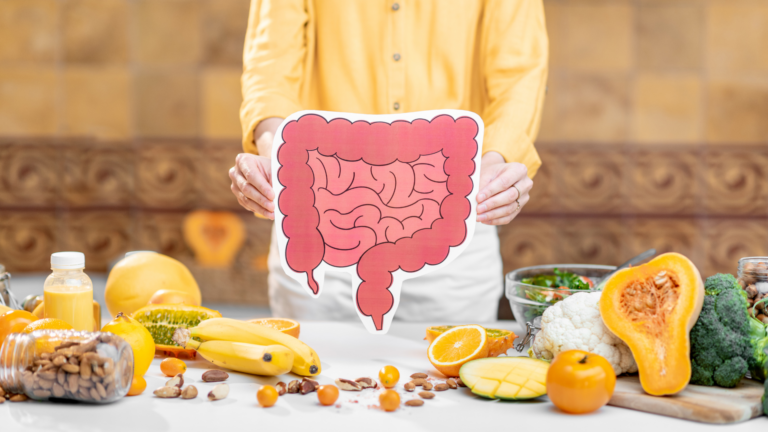Food chemical sensitivities are different to FODMAPs, but they can cause similar IBS symptoms including bloating, wind, pain, constipation and diarrhoea. Interestingly, in some people they also can cause skin, sinus or neurological symptoms as well. If you’ve had inconsistent results with a low FODMAP diet, seem to react to low FODMAP foods or get symptoms that are not typically associated with FODMAPs, you may want to consider if food chemical sensitivities are part of the picture.
In this article we will cover:
- What are natural food chemicals
- Which natural food chemicals are people usually sensitive to
- How food chemicals trigger symptoms
- Thresholds for food chemicals
- Symptoms that are common with food chemical sensitives
- What foods contain food chemicals
- How to know if you are food chemical sensitive
- How food chemical intolerances are managed
- Where do FODMAP fit
What are food chemicals?
Food chemicals sounds a little scary, but these occur naturally on a range of foods including fruit, vegetables, meats, cheeses, chocolate and other foods. We all eat these, and you do not have to be eating packet foods to be eating them.
Chemicals are actually found everywhere in nature, including in the food we eat and the water we drink. Some of these, like vitamins, contribute to maintaining good health, while others increase aroma and flavour and make food enjoyable. Some plants also contain chemicals that are poisonous to humans and we have learnt to avoid eating these.
Can some natural food chemicals cause unpleasant symptoms?
Some people are more sensitive to these natural food chemicals and find when they eat large amounts of them, they experience distressing symptoms. The most common natural food chemicals that can cause unpleasant symptoms include:
- Salicylates are naturally occurring in many fruits, vegetables, herbs, spices, tea, coffee, honey and mint flavours. They are a natural substance that plants produce to protect themselves from predators in nature. Sometimes salicylates have a bitter flavour or make animals or insects feel unwell when they eat them. Fruits and vegetables are higher in salicylates when they are first picked or less ripe, and levels drop as they ripen and with cooking. They are also present in higher amounts in the skin or outer layers of fruits, vegetables, herbs and spices.
- Amines are produced as a result of protein break down. Foods like meat, cheese and fish increase in amines as they age or mature. Some fruits of vegetables increase as they ripen. Fermented foods and cured foods are also higher in amines than their fresh counterparts
- Glutamates are an amino acid and a part of all proteins. In foods they may be found attached to a protein or in their “free” form. When they are found in their free form they enhance the flavour in food. Foods rich in natural glutamates like cheese, tomato, mushrooms and meat/yeast extracts are often used to flavour cooking. MSG (pure monosodium glutamate) is used as an additive in savoury snack foods, soups and Asian cooking.
How do food chemicals trigger symptoms?
When foods that contain natural food chemicals are eaten they are digested and absorbed normally into the blood stream. Once in the blood stream they are metabolised and flushed out of the body like other nutrients the body doesn’t need or want to store. Reactions to food chemicals are dose related. It’s thought that when there is enough of a particular chemical in your blood stream to push you over your threshold, they will irritate nerve endings in different parts of your body. Similar to how some people experience side effects form certain medications.
It’s important to note, that although food chemicals can cause distressing symptoms they may mimic allergies, they do not involve the immune system at all and do not trigger anaphylaxis
Do people have different tolerance levels to food chemicals?
How much you can tolerate will vary depending on how sensitive you are. Some people have a much lower tolerance threshold than others and will experience a reaction to smaller amounts. Others though, will find that levels build up over a few days (stacking) before their tolerance threshold is breeched and they experience symptoms. Chronic or recurrent symptoms can occur when small amounts of high chemical foods are eaten regularly. When this happens levels build up in your system gradually and specific triggers are not obvious. This can be very confusing and frustrating as we often see people tolerate a food one week and then not tolerate the same food the next week. This is due to the stacking effect. In this case it’s not just one food that is the issue, but multiple foods eaten in different combinations.
What symptoms do they cause?
Symptoms vary in appearance and severity from person to person. Since they are systemic they can occur throughout the body. The most common ones are:
- Skin irritation like rashes, eczema or hives
- Airway irritation like sinus, asthma, post nasal drip
- Nervous system irritation like headaches, fatigue, flu like aches and pains, moodiness or in children behavioural problems including ADHD.
- Gastrointestinal irritation, including reflux, mouth ulcers, bloating, cramps, diarrhoea or constipation or both.
What foods contain food chemicals?
Food chemicals are found in a great variety of foods, many of them are generally considered healthy. Often one or two of these foods eaten in isolation are well tolerated, but in larger amounts or when combined with other high chemical foods they contribute to overall load, just like the straw that broke the camel’s back. When it comes to foods, its important to know that food chemical sensitivity is all about stacking! It’s not uncommon for someone to tolerate a food one time and then not tolerate the same food another time.
The following lists are some examples and are not exhaustive.
- Salicylates: Strawberry’s, capsicum, stone fruit, citrus fruit, pineapple, grapes, coffee, tea, herbal tea, honey, herbs, spices, wine, beer, peppermint, juices and nuts
- Amines: Chocolate, ripe bananas, soft avocado, ripe tomatoes, aged cheese, aged meat, tinned fish, stock, marinades, wine and beer
- Glutamates: Chinese food, commercial savoury foods such as sauces, soups and snack foods, soy sauce, tomato, mushrooms, grapes, some cheeses, vegemite and wine
- Artificial additives, colours and preservatives: Fruit juice, soft drink, cordial, bread, dairy products, processed meats (ham, bacon), snack foods and confectionary
How do you know if you are sensitive?
Since the immune system is not involved, there are no reliable diagnostic tests and the only way to know for sure if a food is triggering your symptoms is through an elimination and structured re-challenge process. This can be a difficult process and there are many factors that could mislead results, so this is best done under the guidance of a dietitian with expertise in food intolerances.
There are many tests that claim to diagnose food intolerances, but most are unreliable, expensive or both. You can read more about this at the Australasian Society of Clinical Immunology and Allergy (ASCIA) here.
How do you manage food chemical intolerances?
Since food intolerances do not involve the immune system or cause physical damage, foods only need to be restricted as far as symptoms dictate. Once you know which foods are causing your symptoms, your dietitian will work with you to determine your individual level of tolerance. This will then dictate how much restriction is required to keep symptoms manageable in the long term.
Since symptoms are caused by irritated nerve endings you may find that tolerance threshold moves over time depending on what else is going on. If you are in a particularly stressful period of life, you may need to pull back a little to prevent or manage symptoms, whereas when things are going well and you are relaxed you may find you tolerate higher amounts of your trigger chemicals.
Where do FODMAPs fit?
If you are familiar with the low FODMAP diet you will notice some cross over with foods high in food chemicals and that some of the food chemical symptoms are similar. It’s not uncommon for people with food chemical sensitivities to get some relief following a low fodmap diet. Symptom relief is usually more noticeable in the initial stages of a low fodmap diet with effectiveness diminishing or becoming inconsistent over time. Other food chemical red flags include persistent unexplained symptoms or reactions to low FODMAP foods or the appearance of a “withdrawal” flare when starting a low FODMAP diet. Withdrawal does not happen with FODMAPs, but about 50% of people who are food chemical sensitive will experience withdrawal symptoms when first lowering their food chemical load.
Final thoughts
One of the things I love about being a dietitian, is that nutrition and food intolerances are seldom black and white. Food chemical sensitivities can occur in isolation, alongside other intolerances, including FODMAPs, wheat, cow’s milk protein, coeliac disease or allergies.
If you think you are having issues with food chemicals make sure you see a dietitian with expertise in food intolerances. They can help you put together an effective management plan to assist in managing your symptoms.
Everyday Nutrition dietitians are trained and experienced in food chemical sensitivities FODMAPs and whole food sensitives. We specialise in supporting people to resolve digestive issues and make peace with food. Book an appointment here to gain back control of your gut.
Reference: This blog was written following my attendance at a Dietitians Workshop at the RPA Hospital Allergy unit in Sydney Australia








5 Comments
it has taken 25 years of illness to know this is my problem, although i cannot tolerate starch in food, the low chemicals food guides give me some direction in planning my meals. thqnkyou for the articles. p.s. Ihave pages of symptoms from food diaries I have kept over the years
So glad the article was helpful. It’s a lessor known sensitivity, but can be a light bulb moment for people who fit the profile. Let me know if we can help guide/support you 1 on 1 ?